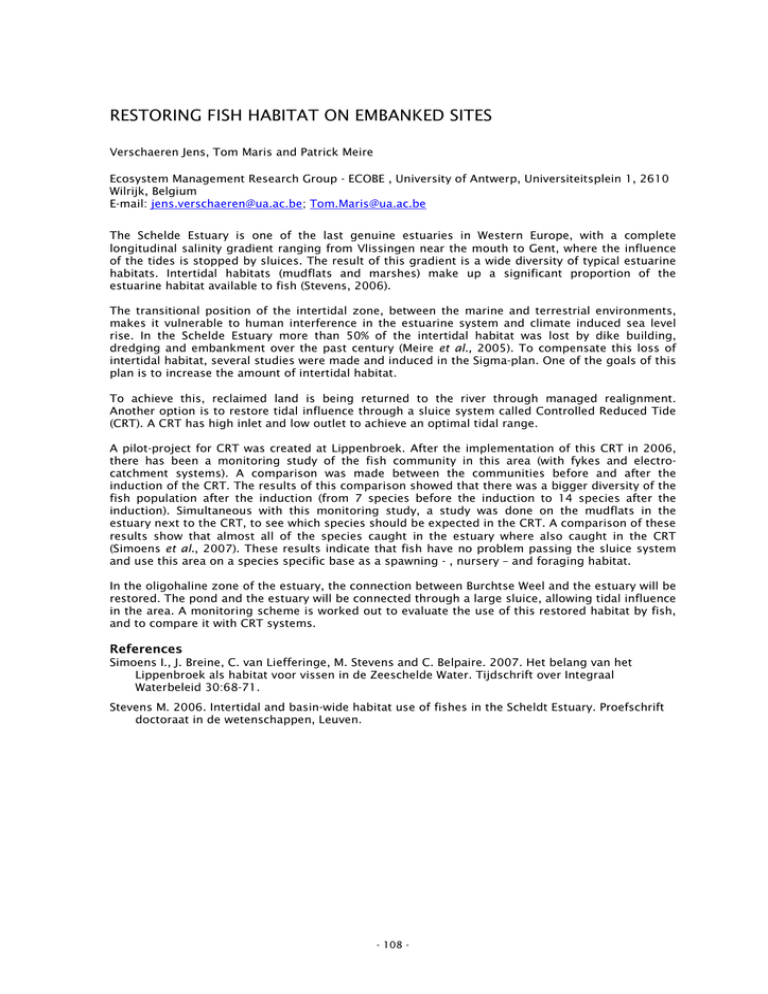RESTORING FISH HABITAT ON EMBANKED SITES
advertisement

RESTORING FISH HABITAT ON EMBANKED SITES Verschaeren Jens, Tom Maris and Patrick Meire Ecosystem Management Research Group - ECOBE , University of Antwerp, Universiteitsplein 1, 2610 Wilrijk, Belgium E-mail: jens.verschaeren@ua.ac.be; Tom.Maris@ua.ac.be The Schelde Estuary is one of the last genuine estuaries in Western Europe, with a complete longitudinal salinity gradient ranging from Vlissingen near the mouth to Gent, where the influence of the tides is stopped by sluices. The result of this gradient is a wide diversity of typical estuarine habitats. Intertidal habitats (mudflats and marshes) make up a significant proportion of the estuarine habitat available to fish (Stevens, 2006). The transitional position of the intertidal zone, between the marine and terrestrial environments, makes it vulnerable to human interference in the estuarine system and climate induced sea level rise. In the Schelde Estuary more than 50% of the intertidal habitat was lost by dike building, dredging and embankment over the past century (Meire et al., 2005). To compensate this loss of intertidal habitat, several studies were made and induced in the Sigma-plan. One of the goals of this plan is to increase the amount of intertidal habitat. To achieve this, reclaimed land is being returned to the river through managed realignment. Another option is to restore tidal influence through a sluice system called Controlled Reduced Tide (CRT). A CRT has high inlet and low outlet to achieve an optimal tidal range. A pilot-project for CRT was created at Lippenbroek. After the implementation of this CRT in 2006, there has been a monitoring study of the fish community in this area (with fykes and electrocatchment systems). A comparison was made between the communities before and after the induction of the CRT. The results of this comparison showed that there was a bigger diversity of the fish population after the induction (from 7 species before the induction to 14 species after the induction). Simultaneous with this monitoring study, a study was done on the mudflats in the estuary next to the CRT, to see which species should be expected in the CRT. A comparison of these results show that almost all of the species caught in the estuary where also caught in the CRT (Simoens et al., 2007). These results indicate that fish have no problem passing the sluice system and use this area on a species specific base as a spawning - , nursery – and foraging habitat. In the oligohaline zone of the estuary, the connection between Burchtse Weel and the estuary will be restored. The pond and the estuary will be connected through a large sluice, allowing tidal influence in the area. A monitoring scheme is worked out to evaluate the use of this restored habitat by fish, and to compare it with CRT systems. References Simoens I., J. Breine, C. van Liefferinge, M. Stevens and C. Belpaire. 2007. Het belang van het Lippenbroek als habitat voor vissen in de Zeeschelde Water. Tijdschrift over Integraal Waterbeleid 30:68-71. Stevens M. 2006. Intertidal and basin-wide habitat use of fishes in the Scheldt Estuary. Proefschrift doctoraat in de wetenschappen, Leuven. - 108 -




